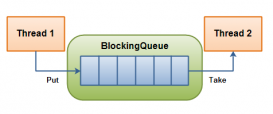java.util.concurrent包里提供了关于多线程操作的类,平常用的比较多的是ExecutorService及其实现类(如ThreadPoolExecutor等),Executor,Executors,Future,Callable等
1. ExecutorService(继承自Executor)接口:提供了一些异步的多线程操作方法,如execute(), submit(), shutdown(), shutdownNow()等
2. Executor接口:执行提交的任务(线程),只有一个方法 execute(Runnable a)
2. Executors类: 提供了一些工厂方法和一些公共方法来操作Executor子类和ThreadFactory等,如newXXX(),xxxThreadFactory()等
3. Futrue接口:代表了线程执行结果,提供了获取线程执行结果和取消线程的方法,如get(),cancle()等
4. Callable接口:JDK1.5提供的有返回值的线程执行新接口
对ExecutorService和Future的理解做简单记录
代码:
|
1
2
3
4
5
6
7
8
9
10
11
12
13
14
15
16
17
18
19
20
21
22
23
24
25
26
27
28
29
30
31
32
33
34
35
36
37
38
39
40
41
42
43
44
45
|
public class Main { private static int count = 0; public static void main(String[] args){ List<Future> resultList = new LinkedList<>(); /** * Executors.newCachedThreadPool() 创建一个线程缓存池,若60s中线程没有被使用,则会停止线程并从缓存池中移除 * Executors.newScheduledThreadPool() 创建一个固定容量的线程池,里边的线程按照设定的调度时间执行 * Executors.newFixedThreadPool() 拥有固定容量的线程缓存池 * Executors.newSingleThreadExecutor() 容量为一的线程缓存池,只会有一个线程 */ ExecutorService executorService = Executors.newCachedThreadPool(); for(int i=0; i<10; i++){ Future future = executorService.submit(new Callable<String>() { @Override public String call() { try { System.out.println(Thread.currentThread().getName()); Thread.sleep(5000); } catch (InterruptedException e) { e.printStackTrace(); } int count = Main.count; System.out.println(Thread.currentThread().getName() + "..start Main count:..." + count); Main.count = ++count; System.out.println(Thread.currentThread().getName() + "..end Main count:..." + Main.count); return Thread.currentThread().getName(); } }); resultList.add(future); } executorService.shutdown(); for(Future future: resultList){ try { System.out.println(future.get() + "..is over..."); } catch (InterruptedException e) { e.printStackTrace(); } catch (ExecutionException e) { e.printStackTrace(); } } System.out.println("main thread end..."); }} |
输出:
|
1
2
3
4
5
6
7
8
9
10
11
12
13
14
15
16
17
18
19
20
21
22
23
24
25
26
27
28
29
30
31
32
33
34
35
36
37
38
39
40
41
|
pool-1-thread-1pool-1-thread-2pool-1-thread-3pool-1-thread-4pool-1-thread-5pool-1-thread-6pool-1-thread-7pool-1-thread-8pool-1-thread-9pool-1-thread-10pool-1-thread-1..start Main count:...0pool-1-thread-2..start Main count:...0pool-1-thread-3..start Main count:...1pool-1-thread-2..end Main count:...1pool-1-thread-1..end Main count:...1pool-1-thread-3..end Main count:...2pool-1-thread-1..is over...pool-1-thread-2..is over...pool-1-thread-4..start Main count:...2pool-1-thread-3..is over...pool-1-thread-4..end Main count:...3pool-1-thread-4..is over...pool-1-thread-5..start Main count:...3pool-1-thread-5..end Main count:...4pool-1-thread-5..is over...pool-1-thread-6..start Main count:...4pool-1-thread-6..end Main count:...5pool-1-thread-6..is over...pool-1-thread-7..start Main count:...5pool-1-thread-7..end Main count:...6pool-1-thread-7..is over...pool-1-thread-8..start Main count:...6pool-1-thread-8..end Main count:...7pool-1-thread-8..is over...pool-1-thread-9..start Main count:...7pool-1-thread-9..end Main count:...8pool-1-thread-9..is over...pool-1-thread-10..start Main count:...8pool-1-thread-10..end Main count:...9pool-1-thread-10..is over...main thread end... //主线程在所有线程执行完成后结束 |
控制台在等待5秒后打印出上边的输出结果,原因是所有的线程启动的时候是一个并发操作,都会去等待5秒,所以整体看来只等了5秒,这是一个并发操作
总结:
1. ExecutorService提供的execute()方法和submit()方法的区别:
a. execute()方法只接受Runnable类型的实例,所以不能拿到返回值,也不能动态获取线程执行的情况
b. submit()方法接受Runnable和Callable实例,会返回Future实例,Future实例的get()方法可以获取线程执行返回值,并能抛出线程执行异常。所以如果要获取线程执行返回的结果,并能处理线程执行时可能出现的异常,或者想中途取消线程执行时可以使用submit()方法
2. 通过输出可以看到main方法(主线程)在所有线程执行完成后结束,原因:
a. 通过submit()方法获取Future实例,并通过Future实例的get()方法获取线程返回结果,而Future实例的get()方法会等待线程执行完毕才会返回,所以main方法会等待所有子线程结束才会结束
b. 若去掉上边红色标注的for循环,则main方法(主线程)会提前结束,而不会等待所有子线程结束
补充:
1. 多个线程并发执行时,若其中某一个线程出现了异常并且没有被处理,则该线程会自动停止执行,但其他线程还是会正常执行,这就是为什么tomcat请求出现异常时,tomcat还可以继续提供服务的原因。
2. tomcat提供了线程池和等待池,每一个请求过来都会重新启动一个新的线程处理该请求,若线程池中线程用完,再来请求的时候就会放到等待池中等待,当其中有线程释放回线程池中时,就会为等待池中的请求分配线程处理请求。
以上就是本文的全部内容,希望对大家的学习有所帮助,也希望大家多多支持服务器之家。













